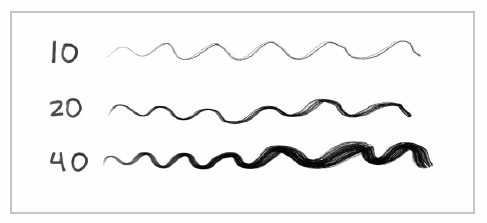Bristle Engine
Paint brushes are made up of a bundle of hair or nylon. Each piece of hair is often called a bristle. The goal of this brush engine is to simulate a real brush. In the real world, traditional brushes all have a round point, but that does not have to be the case in Krita. One of the most unique things that the bristle engine can do is closely simulate a brush as the size becomes larger.

Making your brush size larger will add more bristles to the brush, simulating how a real brush would behave.
In this example, I am using the same brush at three brush sizes: 10 px, 20 px, and 40 px. You will notice that as the brush size becomes larger, there are more bristles that are added. You cannot have this behavior on the Pixel engine. Smaller brushes physically cannot have as many bristles to paint with. This behavior can provide some variety in your artwork instead of simply scaling your brush tip up and down.
Bristle Options
- Scale– Scale your brush size up or down. The effect is similar to adjusting your brush size. Negative scaling will invert the brush tip.
- Random offset – Similar to scattering. Higher numbers will increase the distance between bristles.
- Shear – Shears individual bristles when painting.
- Density – How many bristles to apply. Lower values will have a more spotty look. This will be applied in addition to the Brush Tip density.
- Mouse pressure – If drawing with a mouse, this setting simulates pressure at the ends of your stroke being lighter.
- Threshold– This is a graphics tablet feature. When you turn this on, only bristles that are able to “touch the canvas” will be painted.
- Connect hairs – Adds connecting lines to bristles to get a scratched look. This effect is dependent on your Random offset.
- Anti-aliasing – Smooths the brush tips that are applied on the canvas.
- Composite bristles – A difficult-to-see effect that combines the bristle colors within one dab.
Ink Depletion
This controls how much painting you can do before your paint “runs out”. The higher the number, the longer the brush will continue to paint.
- Opacity – As you make your stroke, your brush opacity will be reduced.
- Saturation – As you make your brush stroke, your saturation will become more gray.
- Soak ink – Picks up the underlying layer when making a stroke. This works similar to a smudge brush.

Note
Turning on Saturation Weights will turn off the Opacity portion, so your ink will not become transparent.
Saturation Weights
These control the saturation values based on different brush parameters. These settings are tricky since they use percentages of properties.

